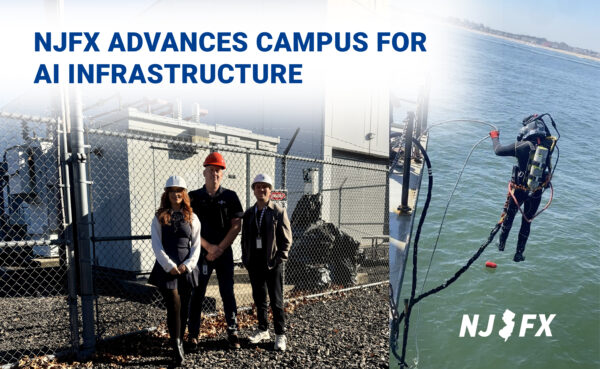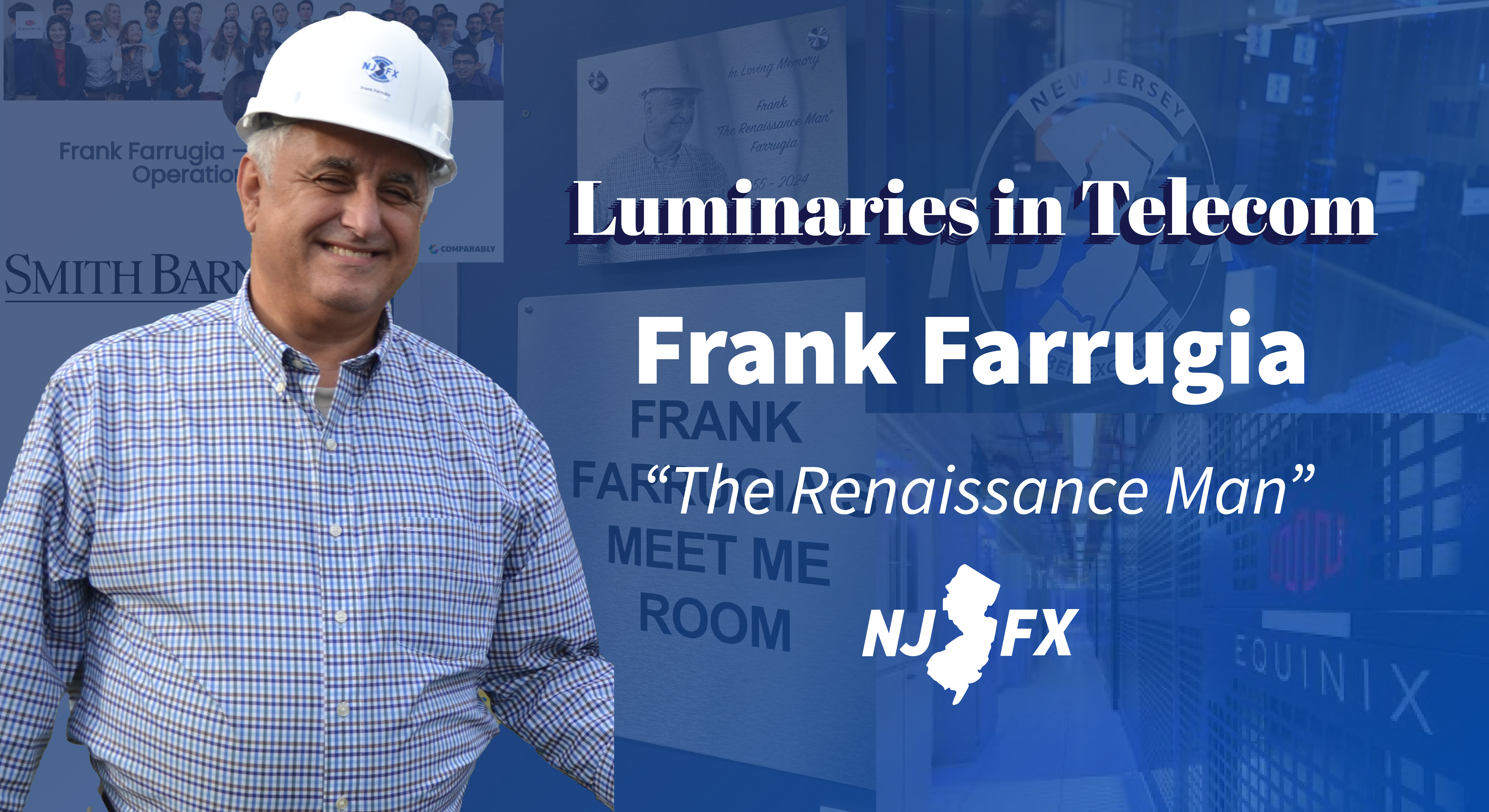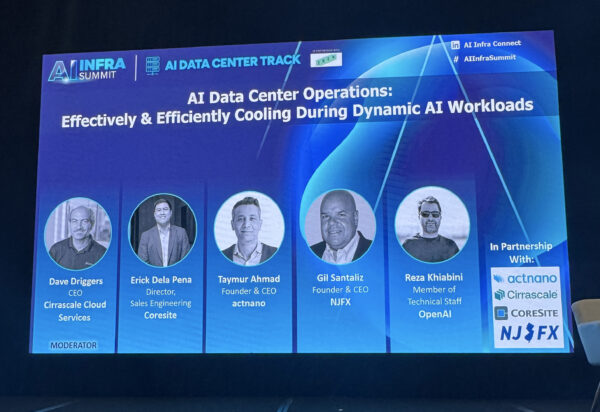
NJFX Advances Campus for AI Infrastructure
NJFX today announced the completion of a comprehensive Basis of Design for a new 10MW high-density AI data hall, delivering an expected 1.25 PUE and 8MW of usable IT load.
the Renaissance Man
Emily Newman
August 13, 2024

In the competitive and ever-evolving world of data center infrastructure, no name stands out like that of Frank Farrugia, coining him “The Renaissance Man” of the industry. Rising from humble beginnings, Frank’s journey from a young immigrant with boundless determination to a revered industry visionary is nothing short of extraordinary. Known for his brilliant mind and innovative spirit, Frank not only set new standards in critical infrastructure builds but also mentored countless individuals along the way, leaving a lasting impact that continues to shape the industry today.
Frank’s legacy includes groundbreaking contributions to major projects at Equinix, where his designs and solutions are still in use, as well as the construction of the purpose-built facility, NJFX. Despite his monumental achievements, Frank remained humble and focused, never seeking the spotlight for his accomplishments but always ready for the next challenge. This Luminary piece is dedicated to honoring Frank Farrugia’s unparalleled contributions and the enduring influence he has had on all of us within the telecom industry.
Frank Farrugia’s early life was marked by resilience and determination. His daughter, Francesca, shared insights into his upbringing, “He grew up in Alexandria, Egypt, which is interesting because his father was in the British Army, and he was mostly raised by his grandparents. He came to the US as a teenager and started from the ground up. No job was too small or beneath him.”
“As a teenager, he took on various jobs to make ends meet, including working as a taxi driver, a food cart operator, he would do anything to get by, slowly but surely working his way up,” she added.
These diverse experiences instilled in Frank a relentless work ethic and a knack for problem-solving that would define his career. Francesca recalled, “He eventually became an engineer. Solving problems was his passion, no situation was too difficult to solve! At work, they would joke that if you needed to move a building 10 feet, Frank would be your guy!”
Frank’s career took a significant turn when he joined Smith Barney, where his talents and leadership skills began to truly shine. I interviewed John Diamond, who worked with Frank as a boss, colleague, and friend. Reflecting on their time together, John shared that Smith Barney had acquired Shearson and would go on to acquire Travelers’ Insurance, Salomon Brothers, and ultimately be merged into Citigroup. During this period, Frank served as an assistant chief engineer. John, who was the director of engineering at the Shearson Smith Barney group, managed a team of 65 engineers and electricians. In a building complex that had suffered from low morale and indolence, Frank stood out as one of three people who took the initiative and worked tirelessly as an example of how rewarding action and productivity are in and of itself.
John described how Frank, along with two other diligent colleagues, created a highly effective team. John assigned them tasks every day, and they tackled a vast array of work in their major data center, a 12-megawatt facility, which was a substantial operation at the time. They also managed a 4,000-seat trading floor operation and operated across seven buildings, totaling over 3 million square feet of technology space in Brooklyn, New York, uptown, midtown, and downtown. Frank drove a work ethic change on all maintenance and repair activities in these facilities, which in turn allowed operating staff to take on new skills and involvement throughout the portfolio.
Frank’s exceptional leadership and hands-on approach were instrumental in transforming the work culture at Smith Barney. His ability to inspire and mobilize his team set a precedent for his future achievements in the industry. Frank’s relentless drive and commitment to excellence were contagious. He was the type of leader who led by example, never asking anyone to do something he wouldn’t do himself. This approach fostered a sense of camaraderie and respect within the team. It wasn’t long before other engineers and technicians started to take notice and wanted to be part of Frank’s crew. The work environment began to change; there was a noticeable increase in productivity and morale.
Over time, the team’s success became evident. As John explained, “Those three guys created such a great work environment, a fourth guy would join, then a fifth, and a sixth. Over time, everybody wanted to participate and be part of that group. Their pride really started to take off. After about five years, which is about as long as it took for me to get that off the ground with Frank as a key ingredient, they became self-sustaining. We hired much higher quality personnel and allowed the entire staff to take pride in their expertise. They made decisions for themselves. It was quite self-developing. It was probably one of the most productive experiences of my life, taking an absolutely toxic situation and converting it into a very respectable, desirable place to be.”
John also highlighted the remarkable transformation within the team: “We became one of the top teams in New York among all the financials. We all knew each other, talked to each other, and competed against each other. Frank was key to that.”
One notable project that exemplifies Frank’s ingenuity and resourcefulness was at the Brooklyn Army Terminal, a large warehouse facility that printed publications for Smith Barney, Salomon Brothers, and Travelers. The facility’s forklifts, driven by inexperienced employees, frequently damaged expensive printing equipment. Frank devised a solution by creating a guardrail program. When faced with an exorbitant $3 million quote to install steel protection, Frank took matters into his own hands. He commandeered the janitorial team, bought the steel himself, and created an assembly line with drill presses and welding equipment, completing the project at a fraction of the cost.
Frank’s problem-solving skills and engineering mind were already evident in his work. Frank had a background in machining, having experience in what was called a “bicycle shop” in New York, which involved contract machining. He would re-machine broken pieces, whether it was a pump, valve, or some unique component. This experience gave him a keen awareness of how to make things and a creative approach to working with metal. He learned welding and other skills on his own, demonstrating his self-taught expertise and resourcefulness.
John highlighted Frank’s quick thinking and creativity during his earlier career. Frank was able to actualize abstract concepts and come up with creative solutions. He was always quick on his feet. When he had an idea, you could see his face light up. He wouldn’t just let ideas sit; he would immediately start thinking about how to implement them. This mentality made him an invaluable asset in any project.
Frank’s last position at Smith Barney was Chief Engineering at 7 World Trade Center. On the tragic day of 9/11, Frank’s leadership and quick thinking were put to the ultimate test. He was working when the building started shaking and crashing sounds were heard. While many initially thought it was an accident, Frank knew immediately that it wasn’t. He insisted on evacuating the building, despite facing resistance from the management on the floors. Frank managed to convince others to evacuate and even helped carry a handicapped man out of the building. In an extraordinary act of bravery, he went back into World Trade 7 with FBI agents to get blankets and medical supplies for the bodies on the ground. Frank’s fight or flight kicked in demonstrating his characteristic decisiveness and courage during high stress moments.
In 2001, after the traumatic events of 9/11, Frank got out of New York City to start on other projects. When his building went away, so did his responsibilities, and he was released as a chief engineer. He then did an interim job where he met Anthony Sclafani, who worked at Morgan Stanley. Frank would later bring Anthony over to Equinix where he continues as Senior Director today.
During this time, John was in contact with Mike Poleshuk from Equinix. Equinix, struggling during the dot-com era, had started to turn things around. Mike, who had just started with Equinix, needed help, and John suggested Frank. John described Frank as someone whose work you would love but wouldn’t want to know how he did it.
Frank began working directly for Mike, and those who worked with Frank often progressed well in the organization. Mike went on to become the Eastern Board Director of Operations and VP of Operations for Equinix, running all operations and construction for the entire eastern half of the US.
At that time, the EVP of Operations, effectively the unnamed COO, was Sam Kapoor. Sam was credited with single-handedly saving Equinix post-2000 by cutting and reducing construction and maintenance costs. Frank became key to that effort. As Sam toured different regions, he saw Frank’s work and realized Frank had an incredible gift. Despite being in the labor force rather than management, Frank’s insights were invaluable. Sam respected Frank’s expertise and often sought his advice on what should be done.
Frank worked closely with the design and construction teams, often challenging their designs. He would review electrical and mechanical drawings, pointing out flaws and suggesting improvements. His practical approach and hands-on experience made him an invaluable asset. Over time, the design teams began to listen to Frank’s recommendations, which led to significant improvements in efficiency and space utilization.
One of the main challenges was designing for the power and space requirements of data centers, such as 5 kW per cabinet or 200 watts per square foot. Frank was responsible for identifying and repurposing space that was not initially designed to be data center space. He redesigned, recreated, and reconstructed these spaces, significantly enhancing the New York portfolio’s capacity. His innovative solutions helped Equinix navigate through the challenging post-dot-com era, making the most out of available resources.
Frank’s role at Equinix was pivotal during a time of significant transformation and growth for the company. His expertise in engineering and problem-solving became a cornerstone for many projects. Working closely with Mike Poleshuk and Sam Kapoor, Frank’s contributions were critical in streamlining operations and reducing costs. The design changes Frank made to Equinix are certainly responsible for hundreds of millions of dollars in revenue and his designs are still in use today, showcasing the lasting impact of his work.
After years of groundbreaking work at Equinix, Frank was ready for a new challenge. He was approached to design a building to support an existing cable landing station (CLS) as their data center. Frank took on this project, bringing every skill he had developed over his career to NJFX. At NJFX, he implemented onsite tilt-up panels and other unique building solutions that he had picked up from previous projects. His vision and leadership were instrumental in establishing NJFX as a critical hub in the connectivity landscape.
Felix Seda, General Manager at NJFX, shared his experience offering a personal glimpse into Frank’s character and his profound impact on those around him. Felix shared, “Frank was my first friend and mentor in the industry. Upon joining NJFX, my first role was clear: shadow Frank, learn as much as possible, and watch the magic unfold.”
Frank was very direct, but deep down, he had a heart of gold and was always ready to step up and help no matter the situation. “Watching Frank in action when he was engaged with vendors and customers was a unique experience,” Felix adds, “He could go toe-to-toe with anyone and frequently did, defending his choices in building NJFX.”
During the period between starting at NJFX and opening the facility, Felix spent more time with Frank than anyone else. This time was chaotic, fun, and one of the best memories of Felix’s young adult life. Despite having no prior knowledge or history in the industry, Frank saw Felix’s ability to grasp things quickly and trusted him as both a colleague and a friend. Frank was a relationship guy and extended himself to anyone who needed it.
Felix recalled, “When I initially transitioned from NYC to New Jersey, I was moving my sofa into the apartment and quickly realized that it wasn’t going to fit. I called Frank, and 30 minutes later he showed up in cargo shorts and a saw, ready to cut a piece of the sofa so we could fit it in.”
Frank Farrugia’s journey from a determined young immigrant to a visionary leader in the telecom industry is a testament to his extraordinary talent, relentless work ethic, and unwavering dedication. Throughout his career, Frank consistently demonstrated his ability to turn challenges into opportunities, leaving a legacy at every organization he touched.
From Frank’s early days at Smith Barney to his transformative role at Equinix and his pioneering work at NJFX highlights his relentless commitment. His innovative designs and strategic insights have generated substantial revenue and set new standards for data center infrastructure. More importantly, his mentorship and leadership have inspired countless individuals to strive for excellence.
We miss Frank dearly and can’t stop thinking about how much he would have loved this time of AI data centers and unique cooling solutions. Quick, complex builds were what Frank thrived on. Frank Farrugia, the Renaissance Man, leaves a legacy of brilliance and devotion that continues to inspire the data center industry and everyone within it.

NJFX today announced the completion of a comprehensive Basis of Design for a new 10MW high-density AI data hall, delivering an expected 1.25 PUE and 8MW of usable IT load.

New Jersey experienced an uptick in wildfire incidents during the dry season of 2025, the communications sector faced significant challenges.

New Jersey experienced an uptick in wildfire incidents during the dry season of 2025, the communications sector faced significant challenges.

New Jersey experienced an uptick in wildfire incidents during the dry season of 2025, the communications sector faced significant challenges.

New Jersey experienced an uptick in wildfire incidents during the dry season of 2025, the communications sector faced significant challenges.

New Jersey experienced an uptick in wildfire incidents during the dry season of 2025, the communications sector faced significant challenges.
